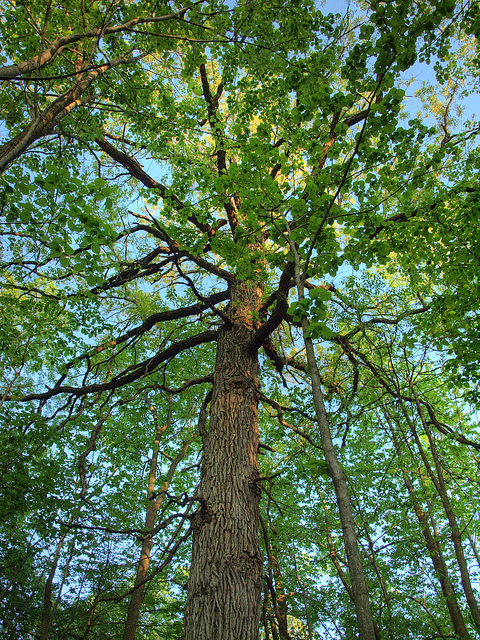
Does Obama’s EPA rule mean welfare for wood?
Almost nothing is more stupid than chopping down trees and feeding them to power plants for electricity. It hurts biodiversity, belches toxic chemicals and contributes more to climate change than coal — all while masquerading as a source of clean “renewable” energy.
Unfortunately, the whole misbegotten enterprise of generating electricity from wood biomass could be getting a boost thanks to the Environmental Protection Agency’s proposed rule regulating power plants.
Bending the rule?
The main thing about the rule is flexibility. Sure, the EPA gets to impose state-level targets for reducing carbon pollution from electricity, but states themselves are allowed to make those reductions in pretty much any way they want.
Barry Rabe of the Brookings Institute calls this the principle of “climate federalism,” since states can mix and match from a long list of strategies that includes everything from increasing overall energy efficiency to expanding renewable energy production. This is where biomass fits in: it is one choice among many for states implementing the rule. No one is being forced to use it; everyone is being allowed to use it.
The problem is that burning wood isn’t a climate solution. It doesn’t reduce emissions and actually makes carbon pollution worse.
When the rule was first released in June, it seemed to suggest that emissions from burning wood would be carefully measured. If states wanted to include biomass in their implementation plans, carbon savings would need to reflect accounting standards that the EPA was still developing—accounting standards that would measure the climate-friendliness of a given piece of wood based on how it was “grown, processed, and ultimately combusted.”
Fast forward to November. The EPA air quality boss Janet McCabe released a policy memo reaffirming that forest products would be a welcome implementation path for states. But she went further, claiming that wood from “sustainably managed” lands would be treated as producing zero carbon emissions. This could mean that as whole trees rise through the smoke stacks of power plants, the companies doing the burning could treat those emissions as effectively non-existent.
This move isn’t final yet, but scientists have already sounded the alarm. If the EPA goes forward with this accounting gimmick, it could mean an additional 4 percent of our total electricity supply coming from wood by 2035–and a commensurate 70 percent increase in the US timber harvest overall.
Scary numbers, with scarier implications for our forests and our climate.
Really renewable?
There is a popular myth, propagated by the timber industry, that wood-to-electricity is carbon neutral. As trees are burned, the argument goes, the emitted carbon is reabsorbed as the trees grow back. But even using rosy accounting assumptions, it could take at least 50 years to work-off the carbon debt and break even with coal. Simply leaving trees alone and allowing them to function as natural carbon sinks is a much more effective way to mitigate climate change.
Part of the problem is that wood is simply an inefficient source of electricity. It emits 50 percent more carbon than coal generating the same amount of energy.
Another industry canard is that biomass electricity is well-positioned to meet its needs from “waste” wood — that is, tree stumps and branches leftover from logging, scraps from timber mills, and recycled wood from demolished buildings. But this exaggerates the amount of spare wood actually there for the taking. In places like the Northeast, where many power plants are already burning whole trees, the amount of available waste wood is already around the total amount of electric biomass capacity.
Even if a small amount of wood could be burned sustainably, creating an incentive to categorize every scrap left in the forest as “waste” probably isn’t a brilliant idea. If wood is allowed to decompose naturally, it emits carbon slowly over time; if it is incinerated, it sends those climate-busting emissions into the atmosphere immediately. What’s more, those leftovers may not be making anyone any money, but they can still be crucial to soil health and biodiversity.
None of this is to dismiss the importance of non-carbon pollution, such as volatile organic compounds, nitrogen oxides and particulate matter, all of which are produced in greater quantities than coal when wood biomass is burned.
Welfare for wood?
So if turning wood into electricity is such a dirty, impractical idea, should anyone worry about its place in the rule? There are at least two reasons the answer is yes.
Firstly, the rule functions by imposing state-level targets for reducing the carbon intensity of electricity. Some states have steeper targets than others, and some of the steepest targets are in states with the highest capacity for wood biomass. This could easily translate into pressure to implement the rule at the expense of our forests.
For example, in the timber heavy northwest, Oregon is being required to reduce its intensity by 48.1 percent and Washington by 71.8 percent. The temptation to reach these goals by cutting corners — and potentially forests — could be considerable.
Secondly, the entire industry enjoys some of the juiciest special interest subsidies on the books. Individual states, especially where the timber industry is most concentrated, offer a bevy of tax breaks and other incentives for both logging and biomass electricity. At the federal level, there is everything from loan guarantees for biomass power plants to dedicated programs in the Farm Bill paying farmers to grow energy crops (including trees).
In fact, overlapping state and federal subsidies allow the industry not only to survive but to thrive. Since 2005, over 70 new wood-burning plants have broken ground or been completed, while another 75 are in various planning stages.
If you have a bunch of states that are going to implement the rule in the easiest, cheapest way possible, and you add in a bunch of subsidies that artificially lower the cost of biomass electricity, then the combination could be a major win for one of the least sensible pieces of our energy mix.
No one should be turning our forests into matchsticks and calling it a solution to climate change. In a rule designed for flexibility, there is no reason to incentivize the dirtiest options on the table.
Image credit: Jim Bauer, Flickr, Creative Commons
Related Posts
Ways to Support Our Work

Read Latest News
Stay informed and inspired. Read our latest press releases to see how we’re making a difference for the planet.

See Our Impact
See the real wins your support made possible. Read about the campaign wins we’ve fought for and won together.

Donate Today
Help power change. It takes support from environmental champions like you to build a more healthy and just world.